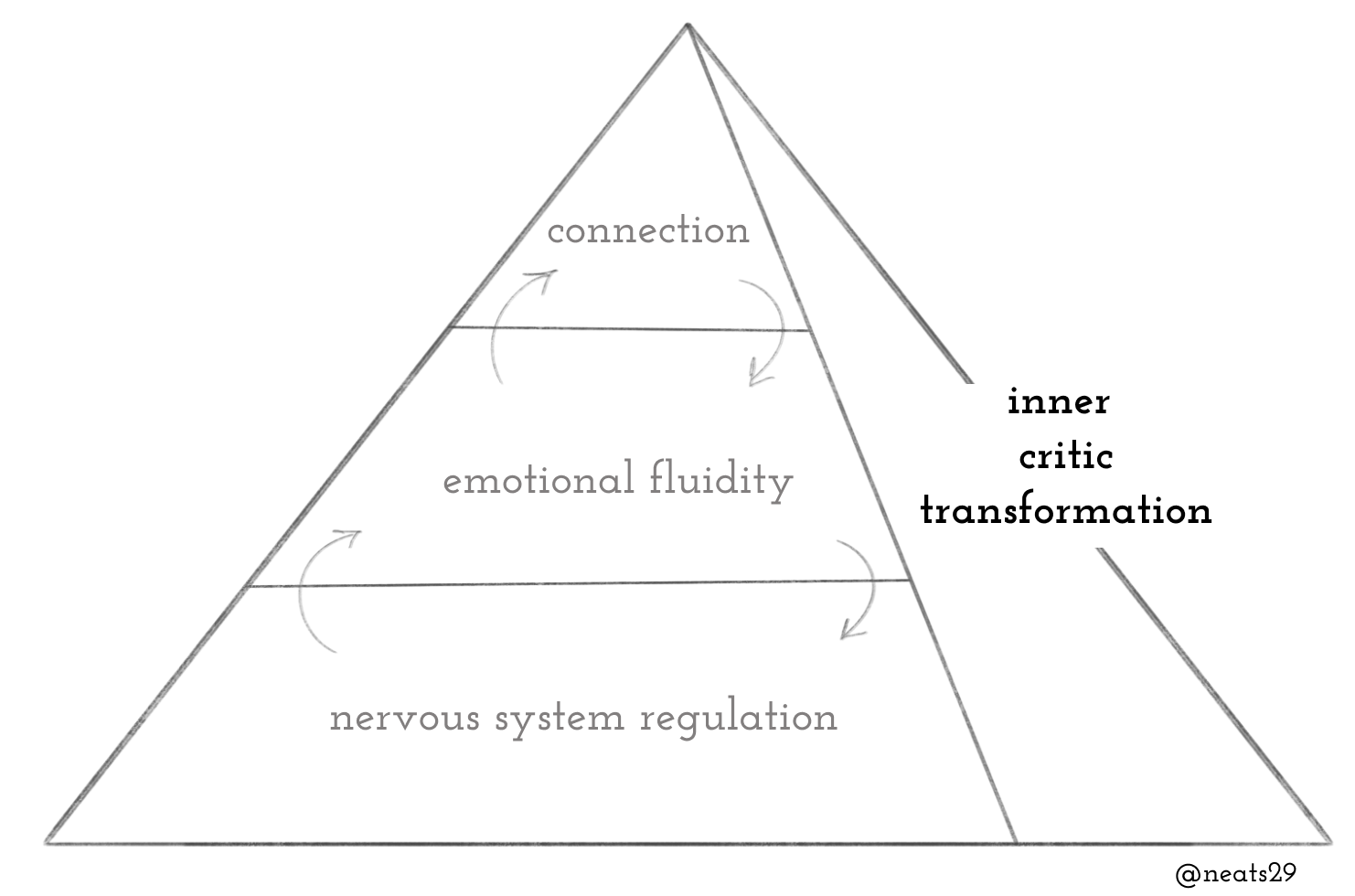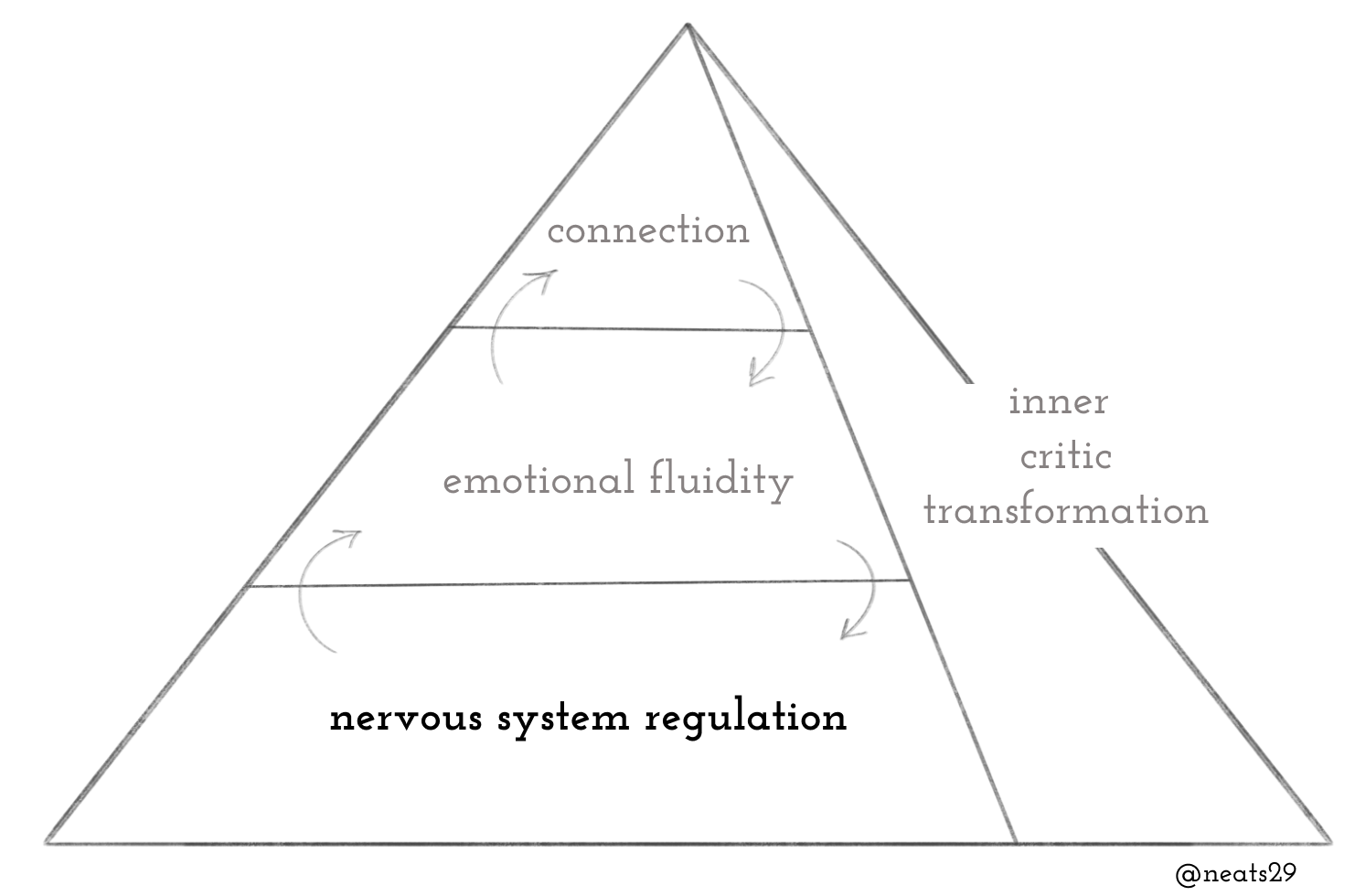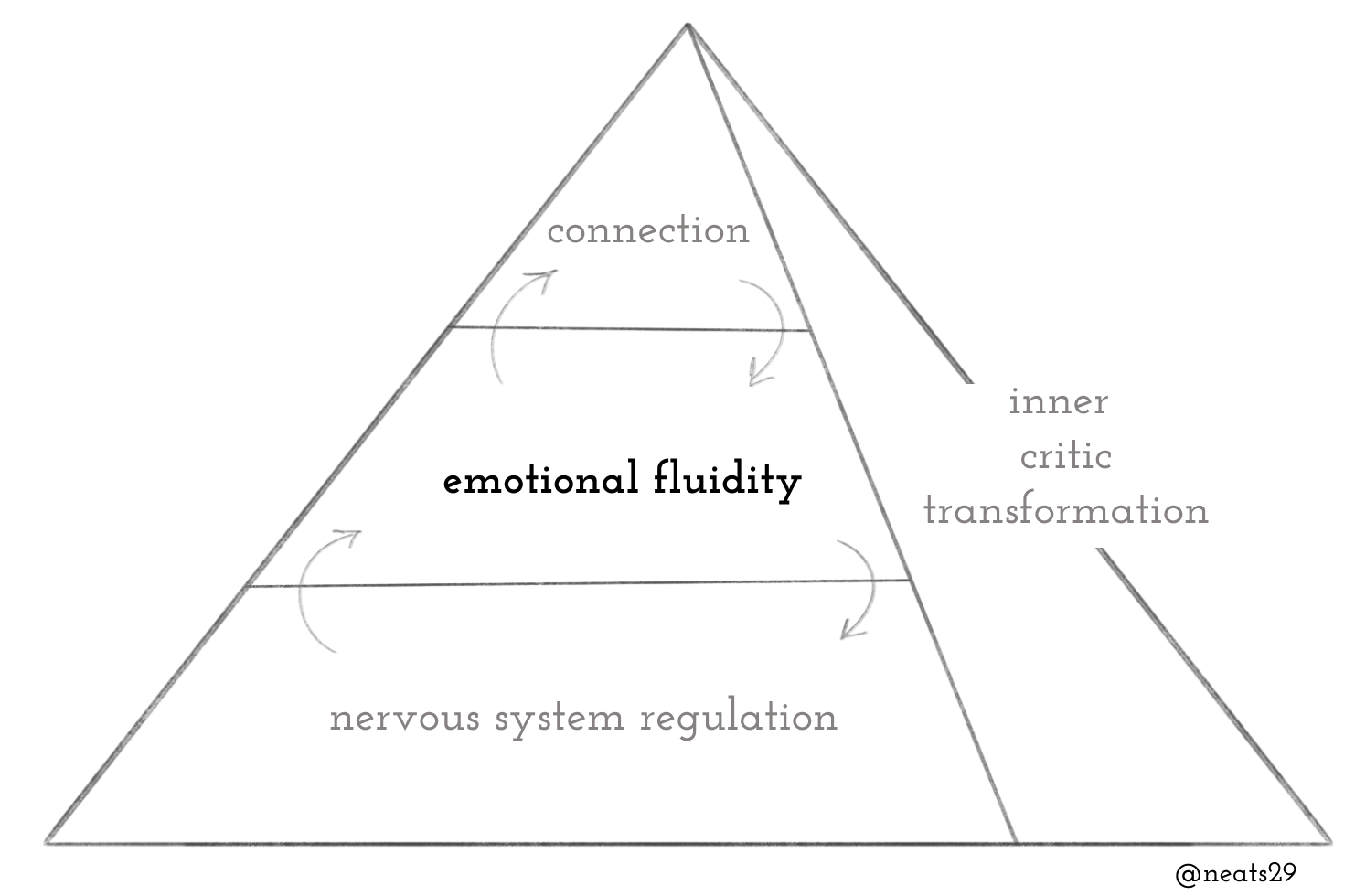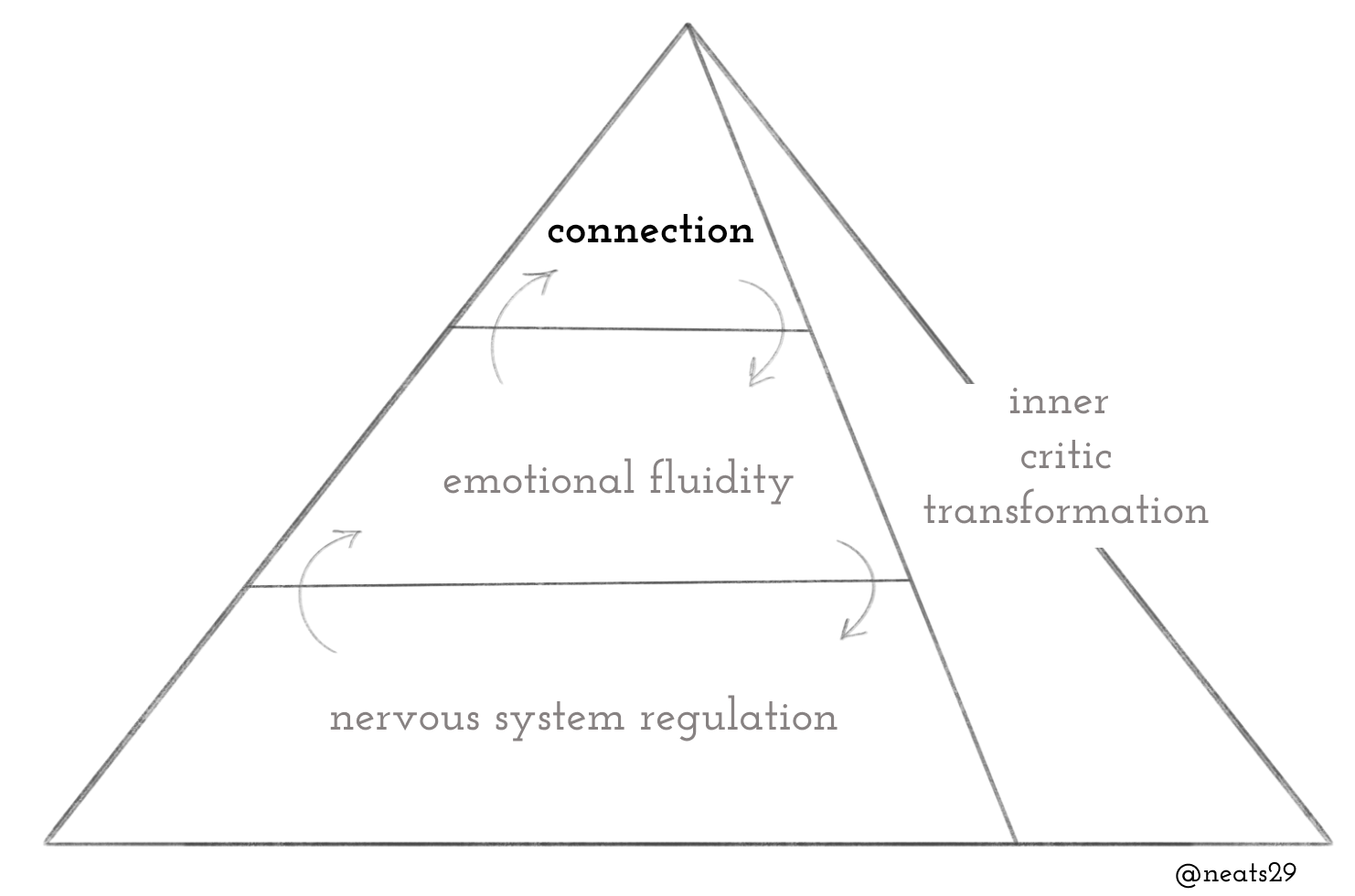Revealing the love within: a framework for self-love
I struggled to find a good opening for this post so here’s the heart of what I’d like to communicate. Learning to love myself was utterly life changing. It’s the most transformative and meaningful journey I’ve embarked on.
Slowly, people started asking about how to do the same so I began to come up with a systematic approach to self-love. I created a framework, rooted in my personal experience, which has also had a significant influence on my coaching practice.
Before I talk about the framework, I’d like to share what self-love has offered me so far:
- Increased feelings of aliveness and joy, and crucially, a higher baseline of well-being
- Improved skills in setting boundaries
- Richer connections, better interpersonal skills, and reduced social anxiety
- Transitioning to a more secure attachment style
- Quicker recovery from and better management of triggered states
- Deepened capacity to engage with contemplative practices
- Significantly reduced the tendency to compare myself with others
Self-love is not achieved, it’s revealed
I have a hunch, based on my personal experience and that of some of my clients, that self-love is not something to achieve but rather something that is revealed. There’s already a source of unconditional love within us, we just have to find it and dust it off. You can think of it as a gem that is covered in dust. We have to dust off the conditioning; the ways we have internalised other people’s criticisms of us, the ways we have developed coping mechanisms to avoid feeling certain emotions. The ways we have outsourced our ability to experience love, to other people and other things. And the ways our childhood wounds have turned us into the antagonist of our own life story.
And once we find this omnipresent kindling of unconditional love, we can feed the fire, so it can burn stronger and continue to heal our parts. And as you might learn, every part, even the most seemingly harmful, is still acting from a place of love. It’s just misinformed in its method of protection.
“You can search the whole tenfold universe and not find a single being more worthy of love and compassion than the one seated here—yourself” — The Buddha (allegedly ◡̈)
Self-love is a vague and imprecise word, with a marketing problem. So here’s how I’d define it: Self-love is the feeling that “I’m fundamentally ok, and I’m going to be ok”. It’s a realisation that instead of managing, controlling or—subtly or grossly—manipulating others, I am instead empowered to meet my own needs. It’s less judgement of others, because there’s less to judge in myself. It’s the voice of a loving resource that comforts me when I’m triggered or feel insecure. It’s the feeling of spontaneous moments of pure joy towards myself. It’s a broad-spectrum feeling of well-being.
Self-love, you could say, is the harmonisation of the parts within us. It’s the welcoming of the parts we judge, the shadow parts we disown and the parts from which our attention has been denied.
Sometimes I like to call it internal love; that’s the felt sense of it. Some call it Deep Okayness or simply raising your baseline of well-being.
With this piece I hope to create a somewhat systematic approach to self-love. The same approach that informs my Somatic Well-Being Practice and self-love coaching.
Your journey will certainly be different from mine. I’m merely sharing my path.
The framework
The full story that informs this framework has already been shared in a previous essay. So I won’t go into it here. All I’ll say is that the framework is the core essence of what I learned in my 3-year quest for self-love, which sits on top of many years of personal healing work.

On my journey I found 4 core areas that created the most substantial change towards this goal:
- Transforming the inner critic (from a negative, critical one into a kind, nurturing one)
- Regulating the nervous system
- Gaining emotional fluidity – feeling through and safely expressing the emotions
- Connection and belonging
Inner critic transformation

“Your most intimate relationship is the one you have with your thoughts.” — Bryon Katie
I used to suffer from a lot of self-doubt. In addition to that, I’d also incessantly compare myself to others and work myself up about what I should do that I wasn’t doing. My inner critic always wanted to remind me that I wasn’t good enough, that I wasn’t doing enough, that I should be different.
In 2020, I was introduced to anger work via Joe Hudson’s Masterclass course, which permanently changed my relationship to the voice in my head. I learned from Joe that over time when anger doesn’t get expressed, it gets internalised and turns into the critical inner voice. So the logic follows that if you release the repressed anger, the inner critic will be transformed.
“As it’s so often the case, when anger is not allowed, it can turn inward against the self.” — Rob Burbea from the talk “Dukkha and emotions in soulmaking practice”
Many people struggle with the idea of releasing anger. They worry that anger is a destructive emotion, that it’s often frowned upon and they may be judged if it’s seen or heard by other people. Joe makes the important distinction that we are not to express anger at anyone. We are to express/release the anger in private or while being witnessed by an impartial party.
While the most cathartic anger releases are often those that involve the use of the voice and movement (such as punching our fists and stomping our feet), in my coaching, I often recommend a soundless anger work that I call “imaginal anger work”. Here’s the setup:
- Grab a tea towel or a small blanket
- Connect with your anger by speaking from it or identifying bodily sensations (often both)
- Imagine various scenarios for expressing this anger, such as screaming alone in a forest, hitting an inanimate object like a car with a baseball bat, or running as fast as you can.
- Choose a scenario and play it out in your mind while squeezing the towel as if wringing out water.
- Continue to stay connected with the anger and see how else it would like to be expressed
While this method is less physically and vocally expressive, it can still be quite cathartic and it offers a great starting point for those apprehensive about anger work.
Awareness of the inner critic and who it’s mimicking
Simply becoming aware of the inner critic, its tone, and who it reminds you of is a powerful step in dismantling its power. Oftentimes, the inner critic mimics someone influential in our lives, like a caretaker or a partner. When someone judges, blames or criticises us on a regular basis, it eventually becomes self generated. We preemptively mimic the voice to avoid the external criticism. This is how it relates to anger. Perhaps when we adopted this coping mechanism, we couldn’t stand up to the abuse, so instead of getting angry and setting a boundary, we had to internalise it.
How the inner critic jeopardises connection
The inner critic can be especially critical in social situations. Rehearsing conversations, feeling self-conscious during them, and then dwelling on what was said (or not said) afterwards.
Here’s a simple hack I stumbled upon from my meditation practice: when feeling self-conscious or uneasy during a conversation, relax your face. Repeat this a few times until you notice a shift in your experience. Usually, those thoughts correspond to muscle tension. Letting go of the tension helps topple the thoughts. It’s as if those thoughts are post-it notes stuck to your face, doing this makes them fall off. Taking a deep breath, alongside facial relaxation, can also be effective.
Nervous system regulation

A few years ago I faced a pretty difficult bout of burnout. Worry, numbness and fear became my dominant emotions. My fears and anxiety seemed irrational and out of proportion to those around me, but I felt paralysed by them. I would regularly feel completely overwhelmed and immobilised by simple tasks, putting them off for months at a time. My usual ability to express sadness through tears was replaced by an unbearable numbness. This was an unsettling mode of existence that I’d never experienced before.
What I came to learn was that my nervous system–the intricate network responsible for responding to internal and external stimuli–was dysregulated.
The nervous system
The nervous system (as described by Polyvagal Theory) is made up of three main branches:
- Ventral Vagal complex (parasympathetic nervous system): Responsible for rest, digest, safety, social engagement, and relaxation.
- Sympathetic nervous system: Governs the fight or flight response.
- Dorsal Vagal complex (parasympathetic nervous system): Controls the freeze and shutdown reactions.
Dysregulation in the nervous system can be characterised by an overactivity in the sympathetic and/or dorsal vagal branches. This leaves the body in a state of heightened alertness, stress or numbness even when there is no immediate threat.
When a stressful event occurs, such as getting into conflict with another person, the nervous system triggers the sympathetic response and prepares our body to respond accordingly; this is an adaptive response. In a healthy, regulated nervous system, the body returns to the parasympathetic once the threat subsides. In a dysregulated nervous system however, the body struggles to fully transition back into the parasympathetic system. So the muscles that became tense stay tense, creating aches and headaches. Stress hormones like adrenaline and cortisol remain elevated, perpetuating a state of anxiety and high alert.
The role of modern life in nervous system dysregulation
Unfortunately, many individuals experience some level of nervous system dysregulation simply by living in the modern world. This results in a deep, desperate, at times existential need for rest. A hyper aroused self-consciousness in social interactions. A deep loneliness due to the complete or partial lack of community.
In some ways, our lives are safer than ever, with antibiotics and supermarkets and no predators roaming around. And yet, we get emails that cause heart palpitations. Our partners reject our bids for attention because their own attention has been hijacked by 10-second videos. Nature is reduced to having a monstera plant in the living room and wise elders are few and far between.
The path to regulation: safety in the body
Regulating the nervous system involves bringing it back into a balanced state, where all three branches function harmoniously. This creates an appropriate response to stressors while also being able to return to a state of relaxation when the threat has passed.
I call this safety in the body. In my experience, that is the felt sense. Essentially this means that the body perceives the environment as safe, and as a result, being in the body feels safe. It feels good to be in the body, as opposed to other times where “escaping” feels better. In fact, this is a great sign for me to know whether I feel grounded or not. If I bring my attention to the body and my mind wants to escape, it’s a sign that I’m not in a parasympathetic state.
Signs of chronic nervous system dysregulation
- Digestive Issues
- Anxiety, depression, or mood swings
- Sleep Disturbances: Like insomnia or hypersomnia (excessive daytime sleepiness)
- Chronic Fatigue: Persistent tiredness not relieved by rest
- Cognitive Impairments: difficulty with concentration, memory, or decision-making
- Autoimmune Conditions
My gateway drug to nervous system regulation was breathwork. I engaged in daily down-regulating breathing exercises such as box breathing, 4-7-8 breathing, and coherent breathing, among others, for about six months, and continue to practise them to this day. I found the Othership app helpful but there are many other resources available.
Regulating the nervous system: practical techniques
- Down-regulated breathwork
- Voice work – singing, whistling, humming, sighing etc.
- Going for a walk – I recommend a daily walk, preferably a familiar path so your body could get into a flow state without having to pay attention to path finding
- Physical touch with trusted friends and family
- Connecting with animals or nature
- Somatic meditation
- Yoga nidra or body scan
- Movement practices such as free form dance or stretching
- Journaling
Aside from chronic nervous system dysregulation, it’s very helpful to learn to recognise the signs of how your nervous system is doing throughout the day. For example, recognising when your body is staying in the sympathetic branch even after a stressor has passed. For example, if I’ve had a particularly stressful or emotionally triggering day, I notice that my food doesn’t get digested because I feel hungry shortly after eating a full meal. Somatically, it feels like this emptiness in my stomach that doesn’t get satisfied with food. Or I may notice myself performing manual tasks really fast or walking faster than usual. When this happens I acknowledge it and let myself continue to walk fast until the adrenaline is used up. Eventually I will take some deep breaths which will quickly shift my state.
Emotional fluidity

Emotional fluidity is the ability to freely move through a range of different emotions. By recognising, feeling and expressing them. In particular, the skill of learning to feel through an emotion, is one of the most pivotal skills I’ve learned. Pivotal, in that life before knowing how to do this and life after learning it has been markedly different.
I would sit down, close my eyes and feel emotions rising up like a wave, I would surf the wave by noticing and allowing the accompanying sensations in my body, and then another wave would emerge, and I would repeat the process. Sometimes I would notice myself resisting a difficult emotion, I would experience this as the tensing of my muscles. So I would relax my muscles and allow the difficult emotion. Sometimes I would get lost in the story of why I was feeling a certain emotion, I noticed this would stagnate the emotion. So instead I learned to observe the story without stepping off my surfboard. Sometimes I would cry, laugh, express my anger and dance in the same sitting. Afterwards, I would usually feel peace or aliveness in my system.
My hunch is that what allowed me to finally be able to feel through my emotions without getting distracted or dissociated was two things: regulating my nervous system, and working through the backlog of unfelt emotions through IFS (parts work) therapy.
Shadow work
An important piece in the emotional fluidity puzzle is shadow work. Simply put, shadow work is about making the unconscious conscious. Though a more nuanced definition can include the process of uncovering seemingly virtuous traits that mask self-serving motivations or insecurities.
There’s a provocative form of shadow work that I learned from the book Existential Kink. Here, we discover the parts of us that take pleasure in things we find distressing or undesirable.
Say your job is stressful and demanding, and you find yourself regularly complaining about it to your friends. As you investigate, you may discover that you feel frustrated, you feel afraid that it may be never-ending, and you may feel grief for the toll it’s taking on your social life. It would be very helpful to feel through each one of those emotions. And what you may discover with shadow work is that something in you may actually enjoy how demanding your job is. You may find, for example, that something in you relishes the sense of importance and the approval you receive. Or perhaps something in you takes delight in the feeling of victimhood and attention-seeking when you complain about it.
With shadow work, you get to see the full picture. The practice is simple, when you don’t want something, see if something in you, simultaneously rejoices. As you welcome these parts and come to accept and even love them, you will feel more whole.
Dance
Another emotional processing tool that was pivotal in my journey was 5Rhythms, a free-form, non-verbal dance that normally spans 2 hours. The combination of carefully crafted music, along with the permission for the body to move in whichever way it wants, creates a powerful environment to move through a wide range of emotions.
Outside of dedicated sessions, I incorporate free-form dance into my day to microdose the experience. Sometimes, it’s enough to simply dance for the length of a single song to process some emotional tension. Other times, I use it as a tool to work through feelings of stuckness; I cycle through songs until my body spontaneously moves to a song it resonates with. Once I start dancing, I experience a range of emotions, and my state changes completely.
The impact of emotional fluidity on self-love
I recently had a difficulty at work. This triggered some feelings of self-doubt, something that used to be a dominant response whenever things weren’t going well at work. As soon as I could I sat down to feel my emotions. I felt the following emotions:
- Shame
- Guilt
- Sadness
- Anger and frustration
- Hopelessness
- Despair
I worked with each and every one of those and then returned to my baseline. I was then able to identify different actions I could take to tackle the challenge at work and carry on with my day from a calm and rational place.
The next day I noticed some emotions reactivating from the previous day. I felt through each emotion, this time it was mostly shame, sadness and anger. During some anger work, I moved on to some shadow work where I identified a potential way I was engaging in self-sabotage. I saw the wisdom in that self-sabotage; feeling loved and protected by it.
Moving through this entire process and being able to restore my baseline sense of calm is deeply empowering. It creates a positive feedback loop that creates more understanding, acceptance, and compassion towards oneself, which then makes the process more seamless and easier to pull-off each time.
Connection

This section is the hardest for me to unpack because the exact mechanisms are not super clear to me. I could retroactively find evidence to support my experience and the felt-sense I have of the importance of connection, but in the end, I admit it feels equally self-evident and bewildering.
I think it’s important to simultaneously hold two truths:
- We don’t need others in order to love ourselves and in many ways that is the core essence of what self-love is. The realisation that all love is internally generated, and that it can be directed at oneself
- and that for the majority of people, self-love is not found in a vacuum
Of course in some monastic traditions, individuals pursue spiritual growth in isolation, through the process of which they may find self-love. However, in my opinion, those are outlier circumstances, because most individuals simply don’t have access to such a path.
I also feel that there’s a chicken and egg situation in that often what makes us not like ourselves is loneliness and/or disconnection.
This is part of the reason why I haven’t placed connection as a base layer. Once I felt safe in my body and developed more emotional fluidity, I was able to be with people. There was less grasping, less judging and less approval-seeking. And as I developed more self-love, I was able to have deeper, richer connections, which further developed the self-love.
More importantly, relationships often act as mirrors. A person reflects what they see and what they hear when you express yourself. There is value in internalising other people’s love when it feels insurmountable to generate the love internally. When you love me despite my flaws, and when I love you despite your flaws, we learn that we are lovable despite our flaws. The love is not dependent on rectifying the flaw. The love doesn’t depend on flawlessness, despite the claims of our deepest wounds. And when you feel engulfed by shame, perhaps my love can be the counter evidence to that voice.
Lastly, what I don’t like in you, is also what I don’t like in myself. Either because it reminds me of an attribute I lack, or an attribute I wish I didn’t have. So the more I learn to accept that trait in you, the more I learn to accept its presence or absence in me.
Conclusion
In presenting my journey as a framework, I’ve sought to capture the essence that lies beneath each tool. Yet, there are of course as many paths to self-love as there are people.
Perhaps the key takeaway here is that there’s a deeply loving resource that we can tap into, should we wish to connect with it.
Whatever path you take, may it be love-filled.
If you enjoyed this post let me know on Twitter. Tell me your self-love stories!